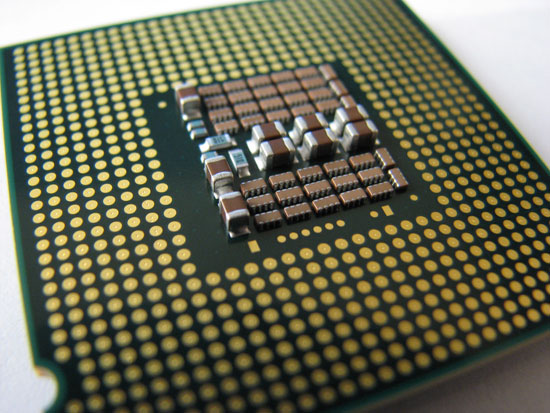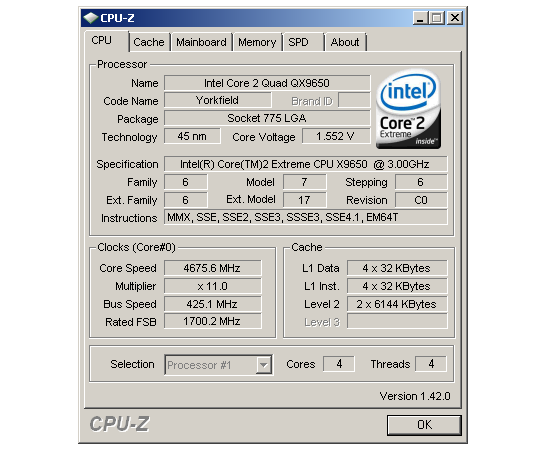Overclocking Intel's New 45nm QX9650: The Rules Have Changed
by Kris Boughton on December 19, 2007 2:00 AM EST- Posted in
- CPUs
Introduction
Intel has once again re-energized the overclocking community with the recent release of the Core 2 Extreme QX9650 quad-core processor, the first of many new mobile, desktop, and server CPUs fabricated using their radically new 45nm process technology. Early results have highlighted Intel's extremely conservative approach in assigning processor power specifications and because of this, users looking to push their systems beyond rated speeds are finding they have a lot more headroom than normally expected. Our overclocking trials have met with great success, as exploiting this processor's hidden performance margin is easier than ever imagined.
The last seven generations of Intel processors have utilized traditional metal oxide semiconductor (MOS) materials, namely silicon dioxide (SiO2) and other polysilicates. This has spanned a period starting with the Pentium, originally built on 0.6 micron (600nm) node technology, all the way to Core 2 Duo/Quad parts built on 65nm. However, for the first time in over 40 years, Intel has significantly changed some of the basic components used in transistor fabrication. Hafnium dioxide (HfO2) has replaced SiO2 as the gate dielectric material, along with other carefully chosen new metals, for use in the formation of gate electrodes in both PMOS and NMOS transistors. These new materials, along with the right process recipe, have cut gate leakage by a factor of more than 10x while simultaneously delivering an astonishing 30% decrease in transistor switching energy. The result is a cooler running, more energy efficient, and high-performance processing powerhouse.

Intel's Core 2 Extreme QX9650 in the classic LGA775 package
Moving to a smaller node process technology allows for the potential of two things to happen. The first is the ability to make smaller production dies, reducing manufacturing costs, and ultimately making products more affordable to the consumer. Alternatively, designers can take advantage of the increased transistor density made possible by the new process and develop next-generation solutions that pack even more transistors into the same space as before. Smaller transistors also allow Intel to take advantage of lower switching energies up to a limit. This is true until smaller and smaller transistor gate dielectric boundary layers create conditions in which power leakage - even with the transistors in the "off" state - become excessive. From this point on something will have to change if Moore's "Law" is going to continue.
With much fanfare, Intel released the highly anticipated Core 2 Extreme QX9650 Processor just a few shorts weeks ago, knowing that the high price would be little more than a speed bump for high-performance enthusiasts. More practical-minded users will have to wait until early 2008 before experiencing the mainstream release. Naturally, we wasted no time in bringing you this first-hand look at the QX9650's expansive overclocking potential. Although our experience has not been entirely without problems - we will cover the good and bad later in more detail - we must commend Intel on the development of another great product. Without a doubt, the QX9650 has taken its rightful place in the winner's circle.

Our maximum overclock on water is nothing short of impressive
Until now, achieving this level of overclock with water-cooling alone was unheard of and we find ourselves feeling punch drunk with the speed. Indeed, finding applications that make practical use of this ridiculous amount of processing power is exceedingly difficult - few programs these days efficiently utilize two cores, let alone four. Obviously, scenarios that make intelligent use of the QX9650's exceptional parallel processing capabilities stand to benefit the most. Good examples are video (and to a lesser extent audio) editing, rendering, ray tracing, 3D modeling, DivX/Xvid encoding operations, and of course gaming (when properly coded and without GPU limitations).
We hope our in-depth look at QX9650 overclocking will provide new information even for those who have been into the overclocking scene for some time. Others, looking for the right opportunity to try their hand at voiding their processor's warranty, should find just about everything they need get started down the long path towards an overclocking addiction. Strap on your heatsinks, tweak your voltages, and join us as we see exactly what Penryn and 45nm brings to the overclocking party.










56 Comments
View All Comments
mczak - Wednesday, December 19, 2007 - link
Granted, that's undervolted, at stock voltage it would be more like 70W instead of 54W :-).I think the criticism of intel's TDP was justified in P4 days, which really did exceed their TDP under high load. Nowadays, the TDP (at least the numbers from intel) is pretty meaningless to the end-user, since cpus with very different actual power consumption have the same rating (QX6850 and QX9650 for example...), but at least all of their cpus actually stay below the TDP.
noobzter - Wednesday, December 19, 2007 - link
I've been waiting for articles like this that delve further into OC's intricacies. Thank you for taking the time to write such an impressive piece!ahackett - Wednesday, December 19, 2007 - link
For someone like me who's fairly new to OC-ing and has been struggling to find a technical and pragmatic introductory guide to the skill, this article is like gold-dust! I look forward to the New Year when I hope to finally remove my E6300 from its temporary ASRock housing and get some decent overclocking done :)Thanks!
BradCube - Wednesday, December 19, 2007 - link
Agreed - Fantastic article. Thanks Kris :)SoBizarre - Wednesday, December 19, 2007 - link
Yeah, the rest of Anand's staff should start thinking about securing their future. Spreading some false rumors about him visiting "Tom's Hardware" office would be a good start. Add to this a couple of sexual harassment accusations and you have a winning combination that would quickly finish his career.Guys, let me spell it for you. If you don’t take action soon, you all will be F-I-R-E-D.
Vortac - Wednesday, November 20, 2013 - link
I still come back to read this article, from time to time. One of the best, really.